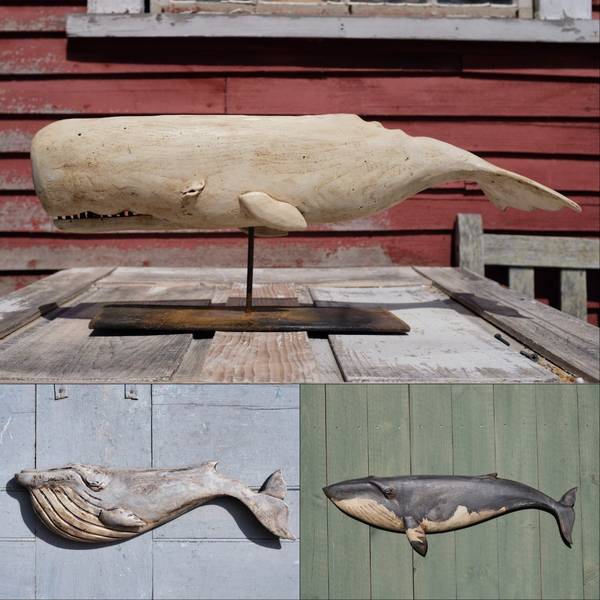
An Ocean Giant in American Chestnut: The Whale Carvings of Wendy Lichtensteiger
While navigating through the challenges of this year, artist Wendy Lichtensteiger turned to a classic story. She downloaded an audio copy of the Herman Melville tale, Moby Dick, and was mesmerized.
“When you listen to it, you understand why it’s a classic.” Adding with a laugh, “For days after I was walking around saying ‘me thinks.’”
The almost 25-hour narration unfolded as she worked in her Vermont studio. The stories of greed, leadership, isolation, and coming together as a diverse community seemed more relevant than ever, inspiring Wendy to carve a new sculpture of that great white whale, Moby Dick.
With a collection of her whale plaques already available at The Drawing Room, Wendy knew this special whale sculpture would be bound for New Bedford, where Melville begins his story.
This Moby Dick sculpture and many of Wendy’s carvings emerge from American Chestnut, a tree that was once the most abundant in the eastern United States until a blight in the early 1900s eliminated nearly every one. Prior to that population collapse, these trees were frequently used to build log cabins, barns, and furniture; its fruit could be eaten both raw and cooked, providing food for animals and humans, alike.
As a child, Wendy was surrounded by American Chestnut. The cabins in the New Jersey lake town where she grew up were built from this storied wood. It was where she developed a love for plants and animals and their interconnected relationships. As time passed and she moved away, the area transformed as new owners began to replace the original cabins with more modern homes.
When one cabin was about to be torn down, she got a phone call: “If you come and get it out of here, it’s yours.”
That cabin was a treasure trove of reclaimed American Chestnut, perfect for carving, once she ripped out all the nails and spikes. Wendy estimates she has enough to take her through the rest of her career, continuing a long tradition of whale carving in Vermont.
Wendy honed her skills working alongside friend and renowned whale sculptor Wick Ahrens, whose own love of whales grew during a mentorship with famed whale carver Clark Voorhees. When Wick officially retired, he asked Wendy to continue the Vermont tradition.
Each whale is unique, revealing itself to Wendy, who finishes the work with milk paint and a five-step antiquing process to bring out the character of the wood and the personality of the whale.
“I love nature. I want to remind people of the beauty and life around them. To respect, care for, and learn from it.”
Wendy continues to be inspired by the natural world and the lessons it can teach us. By respecting its fragile balance, she is able to transform a nearly extinct piece of America’s forests into an expressive giant of the ocean - and literature.
See more of Wendy’s carvings in her collection at The Drawing Room.
Would you like to listen to the tale of Captain Ahab and his pursuit of Moby Dick? Our neighbor the Whaling Museum has a virtual edition of its Moby Dick marathon now available on YouTube.

